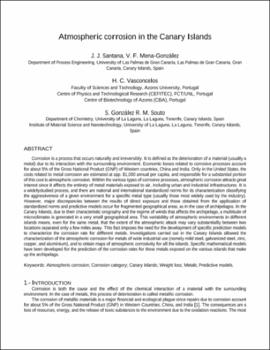Atmospheric corrosion in the Canary Islands
Fecha
2019Resumen
Corrosion is a process that occurs naturally and irreversibly. It is defined as the deterioration of a material (usually a metal) due to its interaction with the surrounding environment. Economic losses related to corrosive processes account for about 5% of the Gross National Product (GNP) of Western countries, China and India. Only in the United States, the costs related to metal corrosion are estimated at app. $1,000 annual per capita, and responsible for a substantial portion of this cost is atmospheric corrosion. Within the various types of corrosive processes, atmospheric corrosion attracts great interest since it affects the entirety of metal materials exposed to air, including urban and industrial infrastructures. It is a widelystudied process, and there are national and international standardized norms for its characterization classifying the aggressiveness of a given environment for a specific metal type (usually those most widely used by the industry). However, major discrepancies between the results of direct exposure and those obtained from the application of standardized norms and predictive models occur for fragmented geographical areas, as in the case of archipelagos. In the Canary Islands, due to their characteristic orography and the regime of winds that affects the archipelago, a multitude of microclimates is generated in a very small geographical area. This variability of atmospheric environments in different islands means, even for the same metal, that the extent of the atmospheric attack may vary substantially between two locations separated only a few miles away. This fact imposes the need for the development of specific prediction models to characterize the corrosion rate for different metals. Investigations carried out in the Canary Islands allowed the characterization of the atmospheric corrosion for metals of wide industrial use (namely mild steel, galvanized steel, zinc, copper, and aluminium), and to obtain maps of atmospheric corrosivity for all the islands. Specific mathematical models have been developed for the prediction of the corrosion rates for these metals exposed on the various islands that make up the archipelago






